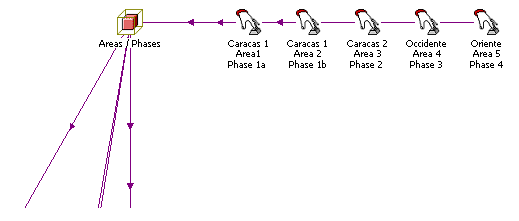Siemens’ Customer Value argumentation team of ICN Carrier Networks (based in Munich,
Germany) has built a model to investigate and evaluate the economic merits of migrating
an existing TDM-based incumbent operator network, CANTV in Venezuela, to an NGN
(IP-based) network. At the same time new services are introduced into the network,
enabling new revenues as well as allowing existing services to be offered to all
subscribers that previously could not use them due to limitations in some of the
old switching equipment.
Structure of the model
The network rollout was planned over a number of phases as well as geographic areas.
The STEM Scenario and Replication features were used in the model. The Scenario
feature was used to allow the effect of the introduction of various new services
over the underlying migration to be evaluated in combination with each other and
individually.

The Replication feature was used to model the different geographic areas, which
differed in their existing installed switch types and vendors, switch sizes and
operating costs, service demand and revenues. The actual solution, calculated for
each type of switch, was matched to the existing switches, re-using components where
possible.

A second Scenario allowed the selection of individual areas or combinations of areas.
The contribution of each area as well as the effect of varying the rollout speed
and sequence was then evaluated. Also modelled was the effect of delaying rollout,
which of course has the consequence of reducing market share as the competition
has more chance to become established.
One Variant of the first Scenario was a “Status Quo” case, i.e. if the network and
services are operated as usual and no investment is made in network upgrade and
NGN, with the associated customer base erosion to competitive operators offering
new services. Using this Variant as the base case, the effects of NGN investment
are easy to show without needing to model the entire operator’s business since the
parts common to all Variants can be excluded.
Concluding issues
Although simply replacing the network would not normally necessarily generate additional
revenue, in this case there were still some old analogue and digital switches in
the network that prevented the availability of all services to all subscribers,
for example pre-paid service which is very popular especially for the lower ARPU
segment. Therefore network replacement also increased subscriber numbers and ARPU.
Another important revenue “protection” effect of an NG network is that the operator
is in a position to offer new services such as IP-Centrex to existing customers,
so retaining them instead of losing them to competitors who are able to offer these
services via an IP connection and are not hampered by not having local exchange
access to the subscribers.
The opex savings potential of the migration was also investigated. Sources of savings
include space, power, site costs (due to site consolidation), staff. Opex savings,
although significant, proved not to be very dominant compared to other costs and
revenues.
The model, built with input from the operator, and its results were very well received
by CANTV and assisted them in making far-reaching decisions on the future evolution
of their network.
Siemens Information and Communication
Networks (ICN) provided solutions for IP-based voice/data convergence, broadband
access and optical transport networks to enterprises, carriers and service providers
in 160 countries.